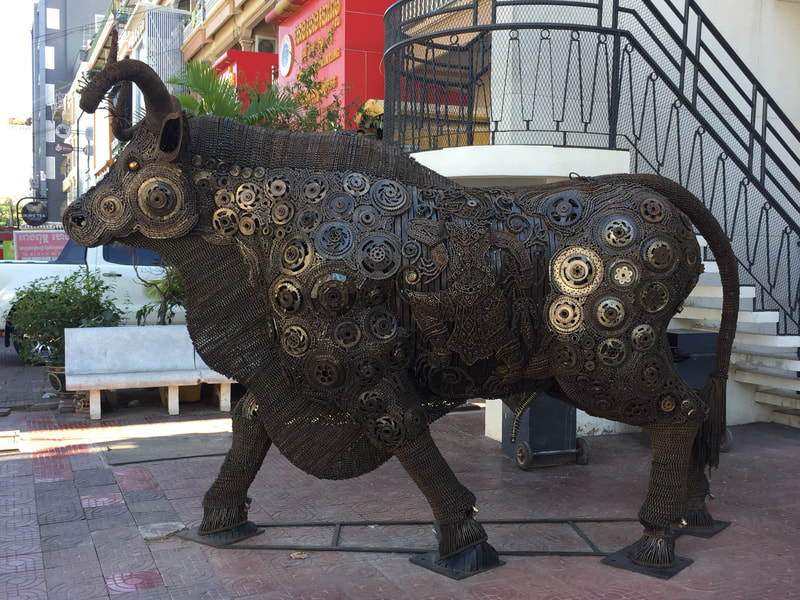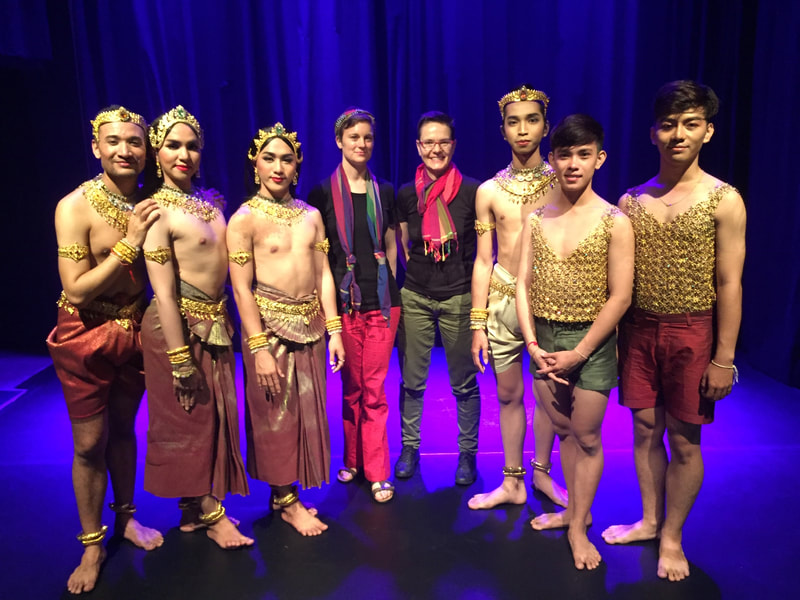Tales of Pacific Pride
|
Everywhere we go the message is consistent: things are relaxing here and the economy is moving. With more money flowing in to the country, there are more opportunities for people. Skyscrapers are appearing on the horizon; shiny investment bank buildings and hotels are springing up. But poverty is still a huge issue, as our meeting with Srorn showed us.
There seem to be two types of businesses here too. Those like Blue Chilli which carve out a space and thrive, and those that look like fantastic start-ups and sputter into life only to close their doors after a couple of years. Today is a hit-and-miss day full of just this kind of contradiction. We're looking for alternate venues for our performances in Phnom Penh and have a list of gallery spaces to view. We’ve got the list sorted and hope that our patient driver, Mr Viriya, finds us more organised today. META House looks promising. Opened in association with the International Academy at the Free University of Berlin, it boasts three floors of gallery space and a media lounge. The open upstairs area would seat around 50. The downstairs gallery is small and currently hosting an exhibition centred around environmental awareness. This seems to be the biggest change in the ten years since we’ve been here: a growing awareness of our impact on the planet. Our hotels offer free water re-fill stations (important in a country where the tap water isn't drinkable) and there’s a move away from plastic straws. Some shops use paper bags made from old newspapers with string for handles. No middle-aged white people here, demanding their right to a plastic bag. Surely it can’t be that hard... As part of her Make Art Not Waste project, Nina Clayton’s 'Ocean Cry' echoes the thoughts of many of us. It’s made from plastic refuse collected from the beach. Another work is a perspex box (60x30x40) full of items the artist has consumed in a five-month period: medication boxes, foil blister packs, cigarette boxes. It makes you stop and think. Despite providing food for thought, META House isn’t going to fit us, and the next two galleries are permanently closed, although their websites look up-to-date. (Pro tip - always double check on Facebook., ubiquitous in this part of the world). Mr Viriya is patient, but we sometimes wonder what he makes of all this. The cool and spacious French Institute of Cambodia looks more promising. There’s a gallery with several rooms of a beautiful exhibition by Caroline Chevalier and students, and an outdoor courtyard. It’s also close to the bridge over the Mekong so would be handy for Sanh and the trans community, provided the venue is one they’d be comfortable in. A certain level of informality is the best way to engage the biggest cross-section of LGBT in this part of the world. The administrative offices across the road have a huge sculpture of a bull on the sidewalk made almost entirely of bicycle chains. But it’s this evening, our last night in Phnom Penh, that we’ve really been looking forward to. We’re off to Counterspace Theatre at Java Creative Cafe (one of three in Phnom Penh), thrilled that Prumsodun Ok & NATYARASA have a show on the weekend we’re in town. Prumsodun Ok & NATYARASA is Cambodia's first gay dance company. We’ve been following them since they popped into our inbox in one of Rambutan’s newsletters, 3 years ago. The fledgling company's website describes it as re-staging: ‘Khmer classical dance with a vital freshness to create original, groundbreaking works at the intersection of art and human dignity. The dancers seek to infuse their tradition with a contemporary spirit, elevating the quality of life and expression for LGBTQ people in Cambodia and beyond.' Prumsodun himself, the choreographer and creative behind the company, is a child of Khmer refugees, born and raised in the United States. Classically trained, he wanted to become an Apsara dancer ever since he first saw this female art-form on a family home video at the age of four. He describes how his Khmer colleagues tried to persuade him to return to Cambodia. Initially he refused, thinking he couldn’t bear living in a country and among a people he loved but not be able to do anything to salve the poverty and hardship. Apsara dance is over 1,000 years old, and, with over 1,500 hand gestures alone, young girls commence training as early as five years old. It’s a complex art, requiring great flexibility of the hands and feet, which makes what we have seen tonight all the more powerful. Of the six dancers on stage, five of them commenced their training in Prum's lounge room only three years ago; the remaining cast member is Prum himself, who started his training in late high school when his sister’s Khmer dance teacher agreed to train him. The hour-long program features four classical dances, an excerpt of Prum’s own show BELOVED, and a contemporary dance duo to Sam Smith's 'Lay Me Down’. The three apsaras who first appear on stage are familiar to anyone who has seen Khmer classical dance - except their chests are bare. This is the only trait revealing their maleness; otherwise, they are as exquisitely dressed, made-up and delicate in movement as their female counterparts. The performance explores both gender fluidity and homoeroticism, with the soundscapes to the excerpts from BELOVED including sensuous poetry along with a dance narrative full of longing and desire. The contemporary duet between two young men manages to be both beautifully executed and vulnerable and raw; the nerves of young love, overlaid with possible fear of rejection (by the beloved? by family? by society?), tremble in every movement. At the end of the show, Prum tells us that classical art is about representing heaven, where all things are perfect and beautiful. He asks what it says about a society when its vision of heaven has no place for you - if there are no gay men represented in heaven, what can it mean except you have no place there: you are nothing; you are dirt; you are unworthy? Prumsodun & his troupe's work in carving a place for gay men in the heaven of Khmer classical dance is claiming an equal space for gay men in Cambodia; another testament to the power of art to create change. If you’re in Phnom Penh, see this show.
0 Comments
Leave a Reply. |
Mel & Sarah
Currently blogging from home, in iso like everyone else, and catching up with PPC19 in the form of a daily photojournal. Archives
June 2020
Categories
|
Proudly powered by Weebly


 RSS Feed
RSS Feed